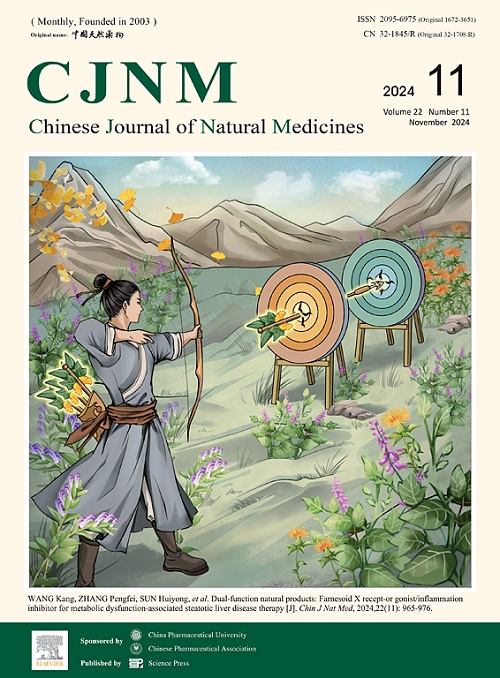海洋内生真菌曲霉的抗皮肤炎症的双酮哌嗪和曲霉胺类蛋白的构型重分配
IF 4.9
2区 医学
Q1 INTEGRATIVE & COMPLEMENTARY MEDICINE
引用次数: 0
摘要
从海洋真菌Aspergillus sp. FAZW0001中分离出两种新型双酮哌嗪(1和5),以及10种已知化合物(2−4,6−12),显示出明显的皮肤炎症抑制作用。化合物1 ~ 5的结构解析和构型重新评价通过综合光谱分析建立,它们的绝对构型通过单晶x射线衍射用Cu Kα辐射,Marfey的方法,并比较实验和计算的电子圆二色(ECD)光谱确定。化合物1、2和8在痤疮丙酸杆菌(P. acnes)诱导的人单核细胞系中表现出显著的抗炎活性。化合物8通过抑制toll样受体2 (TLR2)表达,调节髓样分化因子88 (MyD88)、丝裂原活化蛋白激酶(MAPK)和核因子κB (NF-κB)信号通路的激活,从而降低痤疮假单胞杆菌诱导的细胞炎症反应,从而下调白细胞介素-1β (IL-1β)的表达。此外,化合物8显示出抑制线粒体活性氧(ROS)产生和核苷酸结合寡聚结构域样受体蛋白3 (NLRP3)炎性体激活的能力,从而降低IL-1β的成熟和分泌。采用三维定量构效关系(3D-QSAR)模型对化合物5 ~ 12进行抗炎构效关系分析。本文章由计算机程序翻译,如有差异,请以英文原文为准。
Diketopiperazines with anti-skin inflammation from marine-derived endophytic fungus Aspergillus sp. and configurational reassignment of aspertryptanthrins
Two novel diketopiperazines (1 and 5), along with ten known compounds (2−4, 6−12) demonstrating significant skin inflammation inhibition, were isolated from a marine-derived fungus identified as Aspergillus sp. FAZW0001. The structural elucidation and configurational reassessments of compounds 1−5 were established through comprehensive spectral analyses, with their absolute configurations determined via single crystal X-ray diffraction using Cu Kα radiation, Marfey’s method, and comparison between experimental and calculated electronic circular dichroism (ECD) spectra. Compounds 1, 2, and 8 exhibited significant anti-inflammatory activities in Propionibacterium acnes (P. acnes)-induced human monocyte cell lines. Compound 8 demonstrated the ability to down-regulate interleukin-1β (IL-1β) expression by inhibiting Toll-like receptor 2 (TLR2) expression and modulating the activation of myeloid differentiation factor 88 (MyD88), mitogen-activated protein kinase (MAPK), and nuclear factor κB (NF-κB) signaling pathways, thus reducing the cellular inflammatory response induced by P. acnes. Additionally, compound 8 showed the capacity to suppress mitochondrial reactive oxygen species (ROS) production and nucleotide-binding oligomerization domain-like receptor protein 3 (NLRP3) inflammasome activation, thereby reducing IL-1β maturation and secretion. A three-dimensional quantitative structure-activity relationships (3D-QSAR) model was applied to compounds 5−12 to analyze their anti-inflammatory structure-activity relationships.
求助全文
通过发布文献求助,成功后即可免费获取论文全文。
去求助
来源期刊

Chinese Journal of Natural Medicines
INTEGRATIVE & COMPLEMENTARY MEDICINE-PHARMACOLOGY & PHARMACY
CiteScore
7.50
自引率
4.30%
发文量
2235
期刊介绍:
The Chinese Journal of Natural Medicines (CJNM), founded and sponsored in May 2003 by China Pharmaceutical University and the Chinese Pharmaceutical Association, is devoted to communication among pharmaceutical and medical scientists interested in the advancement of Traditional Chinese Medicines (TCM). CJNM publishes articles relating to a broad spectrum of bioactive natural products, leading compounds and medicines derived from Traditional Chinese Medicines (TCM).
Topics covered by the journal are: Resources of Traditional Chinese Medicines; Interaction and complexity of prescription; Natural Products Chemistry (including structure modification, semi-and total synthesis, bio-transformation); Pharmacology of natural products and prescription (including pharmacokinetics and toxicology); Pharmaceutics and Analytical Methods of natural products.
 求助内容:
求助内容: 应助结果提醒方式:
应助结果提醒方式:


